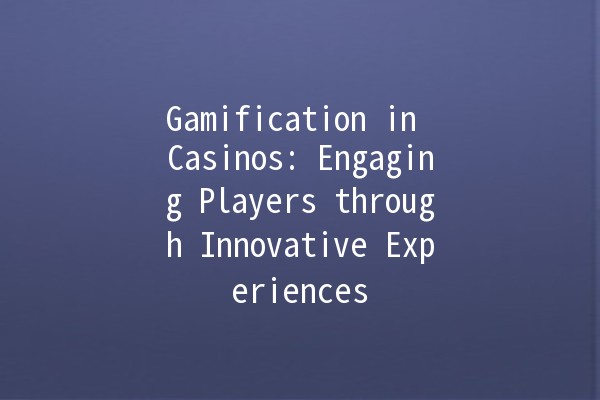As the gaming industry evolves, casinos are seeking fresh ways to engage players, enhance their experience, and drive loyalty. One of the most promising strategies is gamification, which involves applying game design elements in nongaming contexts. This article delves into how gamification is reshaping the casino landscape, providing actionable techniques aimed at improving player engagement and loyalty.
What is Gamification and Why does it Matter?
Gamification is the integration of gamelike elements in nongame scenarios. In the context of casinos, this means incorporating features such as point scoring, leaderboards, and reward systems into everyday activities. The aim is to increase player involvement and make the gaming experience more enjoyable and interactive.
The Importance of Gamification in Casinos

Five Gamification Techniques to Enhance Player Engagement
Description: Traditional loyalty programs reward players with points for their spending. A gamified version can include levels, challenges, and exclusive rewards.
Application Example: Casinos can introduce tiers such as Bronze, Silver, and Gold. Players could progress through these levels by reaching specific benchmarks or completing various challenges (e.g., playing a certain number of hands at blackjack). Each level could unlock exclusive bonuses, ensuring players feel a sense of accomplishment as they progress.
Description: Leaderboards display player rankings based on points earned from various activities within the casino. This fosters a competitive atmosphere.
Application Example: A casino might host weekly tournaments with leaderboards tracking the performance of players. Participants could earn points through various games, and at the end of the week, top players could win cash prizes or bonuses. This encourages continuous play and motivates players to improve their gaming skills for a chance to win.
Description: Transform traditional games into interactive experiences with added challenges that keep players engaged.
Application Example: A slot machine could incorporate a minigame after a player hits a jackpot. The player would have to select objects onscreen to win additional credits. This added layer not only prolongs engagement but builds a sense of anticipation and reward.
Description: Allow players to share their achievements on social media platforms, promoting competition and excitement among their followers.
Application Example: Casinos can implement features that automatically post a player's achievements (such as big wins or leaderboard positions) to their social media accounts. This not only boosts player engagement but also acts as free advertising, drawing in new players who are intrigued by their friends' successes.
Description: Using data analytics, casinos can offer personalized bonuses and challenges that fit the preferences of individual players.
Application Example: If data indicates a player enjoys blackjack, the casino can send targeted promotions, such as double points for playing during a specific time. This tailored approach not only enhances the user experience but significantly increases retention rates.
Frequently Asked Questions
What types of gamification are most effective in casinos?
Gamification is versatile, but loyalty programs, leaderboards, and interactive gaming experiences tend to draw the most engagement. Features that promote competition and personalization resonate well with players, motivating them to participate more often.
Can gamification help attract new players to a casino?
Absolutely! Gamification creates an inviting environment by transforming the gaming experience into something fun and engaging. The excitement generated through competitions and challenges can capture the interest of new players.
How important is player feedback in designing gamification strategies?
Player feedback is crucial. Regularly soliciting insights from players allows casinos to refine and adapt their strategies based on what resonates best with their audience. Continuous feedback loops lead to more effective gamification techniques that cater to player preferences.
Is gamification in casinos just for younger audiences?
While the term "gamification" may often appeal to a younger demographic, its principles can engage players of all ages. By understanding the interests and behaviors of different demographics, casinos can customize their gamification strategies accordingly.
How can casinos measure the success of their gamification efforts?
Casinos can track metrics such as increased foot traffic, session duration, player retention rates, and participation in gamified activities. Utilizing analytics tools to monitor these metrics enables casinos to evaluate the effectiveness of their strategies.
What should casinos avoid when implementing gamification?
It's essential for casinos to ensure that gamification enhances, rather than detracts from, the overall gaming experience. Overcomplicating the process or overwhelming players with too many challenges can create frustration rather than enjoyment.
Gamification in casinos represents an innovative approach to enhancing the player experience. By integrating game design elements into traditional gaming, casinos can foster greater engagement and loyalty. Implementing loyalty programs with unique twists, leaderboards, interactive games, and personalized experiences allows casinos to build a vibrant community of players who return time and again for an exciting and rewarding experience. As the industry continues to evolve, those who embrace and effectively implement gamification strategies will likely see significant success.
This article not only showcases the potential of gamification in casinos but also emphasizes actionable techniques that can lead to improved player engagement and an enriched gaming experience.